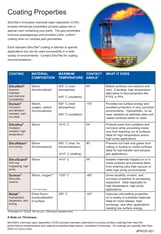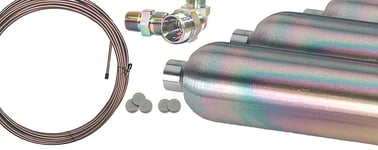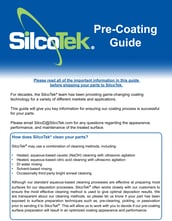
SilcoTek coatings do a lot of things like improving test sensitivity and reliability, improving corrosion resistance, coking resistance and improving mold release. But how to evaluate, buy, and use a custom CVD coatings?
In our previous blog posts we discussed how to select a coating vendor and how industry standards influence coating selection. But how would a customer go about picking, ordering, and using the right coating for their application? Most customers have questions about the overall coating selection process. We're here to give you tips and guide you through selecting custom coatings.
|
In this blog post you will learn:
- How to select a silicon coating for your application.
- Where to get SilcoTek CVD coating data.
- Where to get support and guidelines for evaluating our coatings.
- Learn about our coating manufacturing capabilities.
|
First, before we go through the whole evaluation and buying process, you'll want to watch our coating video to see how we improve the performance of your products. Watching the video will give you a nice overview of our process and let you take a peek into our coating production process. Our coatings are special, you can't just buy a can of corrosion resistant or inert silicon coatings and spray them on your part. You'll need to send parts to us for application at our factory. Why? Because we apply our coating using special high purity silicon that require dedicated coating reactors and surface preparation in order to achieve the highest quality and performance.
Hopefully that helped shed some light on our process. Now we can get into some details about selecting and getting your parts coated. For an overview of CVD coatings and SilcoTek you can start by reading our introductory e-book, SilcoTek 101.

How to Select a Coating
First, we understand it can be difficult to select the right coating for your application. That's why we have Technical Service, Sales, and Customer Service teams dedicated to helping you pick a coating. The world is complicated, we're here to simplify your selection process. Just drop us an email and we'll be happy to help you through the coating selection process.
For more straightforward applications we offer a handy Coating Properties Selection Guide that will give you a quick summary of coating capabilities and primary use. You can also learn about how coatings perform in your application by going to our Coating Application Guide or Coating Applications Page.

Have some time to learn about our coatings. Watch our webinar, how to select the right coating for your application. The webinar is a step-by-step guide to helping the customer pick the right coating.

Get Coating Data and The Facts About CVD Coatings
Have an idea about which coating to use? Great, next you'll want to read about relevant coating data and read whitepapers to be sure the coating will perform. You can get coating information by reading our coating data sheets, coating specifications and coating application notes. You can read studies by independent researchers by going to our Coating Whitepapers page. You can also gain some insights into how other researchers in your industry have evaluated our coatings. Finally you can learn a lot by reading through one of our coating presentations. There's a lot of test data summarized in the presentations. It's a great way to quickly understand the performance capability of our coatings.

Evaluating a CVD Coating

We're here to help you establish coating evaluation guidelines and test methods. If a coating isn't right for your application we'll tell you. We don't want to waste your time and energy evaluating a coating that doesn't work in the application. We can also help you set realistic and effective test parameters. Sometimes customers can set unrealistic test parameters that may fail under all conditions, or they may set test parameters that are so weak that they don't adequately determine if the coating is effective in the application. Contact our Technical Service Team for test guidance. You can confidentially discuss your coating test parameters with one of our research and development team members.
We also offer free test sample coupons to help you evaluate comparable coated and uncoated surfaces. Have a specialized application? We'll be happy to coat a test sample at no charge. Have a question about what tools are needed to evaluate a CVD coating? Our Technical Service Team can advise you on what tools they use to evaluate a CVD coating.
Manufacturing Capabilities
Prior to evaluation, you'll want to know about manufacturing capabilities. No sense testing a part that can't be coated! Learn about what materials can be coated, how large a part we can coat, and if there are any manufacturing limitations regarding part quantity or part configuration. Read our Pre Coating Guide to learn the process basics.

Then get information of basic manufacturing limitations and capabilities:
- Largest overall part size: 2.032m x .76m ID (80in x 29.92in)
- Coiled/Rolled Tubing

- Coated internally-only
- Maximum continuous length: 2500 ft. per coil
- Maximum coil OD for tubing > 1/16" OD: 36"
- Maximum coil OD for tubing 1/16" OD or smaller: 18"
- Must be shipped on a metal spool or bound with metal wire. No spools made of wood, plastic, or other flammable materials.
- Straight Tubing Sticks

- Coated both internally and externally
- Maximum length: 80"
- Minimum part quantity? 1
- Maximum part quantity? Bring it! We can coat lots of parts!
After selecting and testing a coating and reviewing process capabilities you'll want to know about how to quote parts, send in parts for coating service, basic logistics and part pricing. We'll discuss these topics in our next blog post.
Have more questions about our coatings? Go to our Frequently Asked Questions page.











